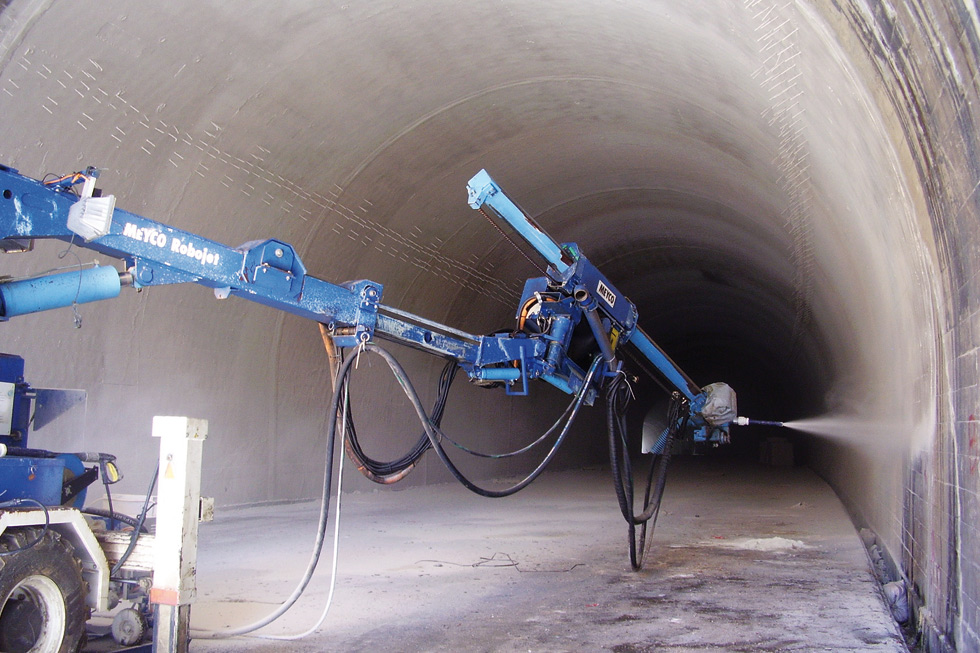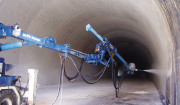The familiar gray substance that coats the walls and roofs of today?s tunnels and mines may not look especially remarkable, but behind the gray lies more than a century of scientific research and product development.
First used in tunnels and mines in 1907 and patented as Gunite, the original blend of sand, aggregates and water quickly became a favorite method of stabilizing a wide variety of structures.
By way of contrast, today?s shotcrete is a far cry from a simple blend. Over the years, it has developed into a multitude of different compositions, carefully designed to suit an ever increasing number of applications. Simultaneously, the equipment required to apply the various compounds have developed into high-tech tools, more advanced and technically sophisticated than ever.
All of this is good news for miners and construction engineers. Not just because of the key role played by shotcrete in helping to keep rock walls in place after excavation and structures in their planned position, but because it can now meet demands for tailor- made solutions.
This is certainly true of applications where sprayed concrete must live up to stringent requirements for high quality, durability, resistance to water ingress, low risk to health as well as low negative impact on the environment.
Dry versus wet
There are two basic types of sprayed shotcrete in use today in tunnels and mines ? dry and wet. For many years, the only way of applying shotcrete was to use a dry mix. This involves a premix of sand and cement which is fed into a hopper. Compressed air is then used to drive the mix in a stream through a hose to a nozzle where water is added.
The wet mix method, introduced in the 1970s, involves premixing sand, aggregate, cement, water and an additive in a concrete plant. This mix is then conveyed by piston pumps through the hosing system to the nozzle where compressed air is used to accelerate the concrete to a speed suitable for positioning the nozzle 1.5 m from the rock surface. Special chemicals known as accelerators are frequently added to speed up the hardening of the sprayed concrete.
The dry mix system tends to be more widely used in mining as it uses smaller trucks and more compact equipment, whereas the wet method, which uses larger equipment and is generally considered more advantageous, is the preferred choice in underground construction.
Another big difference is that a batch of wet mix has to be used right away, whereas the dry mix components can be stored for hours before use. Logistically, it is easier to use a dry mix, but the wet mix has many other substantial benefits.
Significant improvements
Two significant improvements in the development of shotcrete were the introduction of silica fume in the dry mix method ? a biproduct of silicone metals ? and steel or polypropylene fiber reinforcement.
Silica fume, also known as micro silica, reacts with the calcium hydroxide produced during cement hydration. This additive enables shotcrete to achieve twice, or three times the compressive strength of plain shotcrete mixes resulting in an extremely strong, impermeable and durable shotcrete.
Similarly, the addition of steel fiber into shotcrete, which also acts as a reinforcing agent, dramatically increases the tensile strength of the shotcrete and enables miners and tunnelers to reduce the effort of installing wire mesh, thus saving a considerable amount of time and money.
The thickness of the shotcrete layers varies, depending on the mix type and the project requirements, but this is normally up to 50 mm for wet mix and 30 mm for dry mix in one path. In many cases though, thicker application is required which means that multiple layers have to be applied.
A great many parameters are taken into account when matching shotcrete to different applications. These include sand/aggregate grading, cement type and amount, hydration control of admixtures, type of plastiscizers/superplasticizers, workability, accelerator type, temperature, pulsation, nozzle systems, to name a few.
Safety is obviously a major consideration in tunneling but so is speed and cost. Each operation in the tunnel has to be carried out as quickly and as efficiently as possible. The faster the contractor can apply the shotcrete the better it is for the overall economy of the project, and the more likely that the contractor will meet the contracted completion date. Similarly, the more shotcreting time can be reduced, the faster the advance, thereby reducing the costs for tunneling.
Shotcrete of the future
These days, wet mix is now used exclusively in tunneling thanks to its high capacity. On large tunnel profiles such as highway tunnels, up to 24 m3/h of wet mix can be sprayed, whereas the dry mix method would only give a maximum of 10 m3/h.
In this context, MEYCO equipment is extremely economical. Due to a patented control system on the concrete pumps, it gives less waste material, known as ?rebound?, and uses less chemical accelerator thanks to highly accurate dosing systems. Moreover, robotic units keep operators out of danger zones and ensure optimal spraying parameters such as distance of spraying nozzle to rock strata and a consistent spraying angle of 90 degrees, which reduce rebound and give full coverage of rock strata. Robotic equipment also lessens the dependency on skilled operators.
It is true to say that shotcreting is a science in its own right and an indispensable element of modern rock support technology in all subsurface construction. However, the technology is far from complete and the drives to develop new innovations in this field are intensifying. In the future, leading shotcrete specialists, including Atlas Copco MEYCO, will develop new methods and products to further increase functionality, performance and safety.
I believe their success will have a major impact as mines go deeper and tunnels are increasingly driven through weaker rock strata and in increasing length.
Tom Kurth is Marketing Manager at Atlas Copco MEYCO, the international shotcrete equipment specialist, based in Winterthur, Switzerland. He has more than 20 years of experience working with shotcreting technology and application machinery.
Epiroc operated under the trademark “Atlas Copco” prior to January 1, 2018.





Here:
Us: